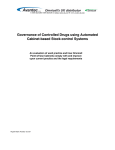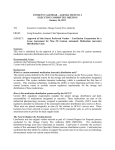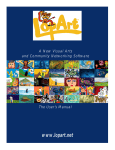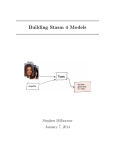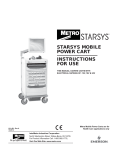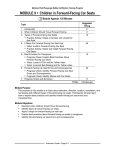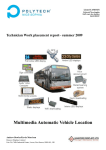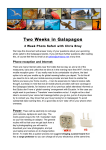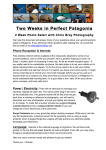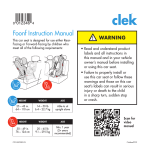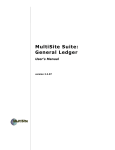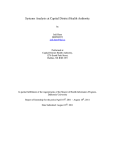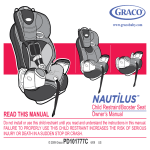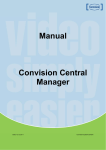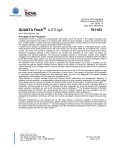Download Policies & Procedures Title: MEDICATION – ADMINISTRATION I.D.
Transcript
Policies & Procedures Title: MEDICATION – ADMINISTRATION I.D. Number: 1170 Authorization: [x] SHR Nursing Practice Committee Source: Nursing Date Reaffirmed: November 2018 Date Revised: September 2016 Date Effective: May 1999 Scope: SHR and Affiliates Any PRINTED version of this document is only accurate up to the date of printing 18-Dec-18. Saskatoon Health Region (SHR) cannot guarantee the currency or accuracy of any printed policy. Always refer to the Policies and Procedures site for the most current versions of documents in effect. SHR accepts no responsibility for use of this material by any person or organization not associated with SHR. No part of this document may be reproduced in any form for publication without permission of SHR. DEFINITIONS Health Care Professional (HCP) – for the purpose of this policy, HCP will be used to refer to Registered Nurse (RN), Graduate Nurse (GN), Registered Psychiatric Nurse (RPN), Nurse Practitioner (RN(NP)), Licensed Practical Nurse (LPN), Graduate Licensed Practical Nurse (GLPN), Physician, Registered Respiratory Technician (RRT), Pharmacist, Paramedic, Medical Radiology Technologist (MRT), Anaesthesia Assistants (AA) and nursing /paramedic/RRT/MRT students. Pharmacy – includes SHR Department of Pharmacy and contracted community pharmacies providing service to residents in LTC homes. Client – resident, client or patient receiving care or services by SHR in the acute, long term or community settings 1. PURPOSE 1.1 To ensure client safety when preparing & administering all medications. 1.2 To comply with nursing, medical and legal standards. 2. POLICY 2.1 All medications shall be ordered as per the SHR Regional policy #7311-60-004 “Ordering of Medications.” 2.2 Medication orders shall be clarified if it is believed client safety will be affected by carrying out the order. 2.3 Refer to SHR Regional policy High Alert Medications - Identification, Double Check and Labeling # 7311-60-020 prior to administering any high alert medication and for specific documentation required. Acute Care: AC Peds, PICU, NICU: also refer to unit specific policies regarding high alert medications. 2.4 Urban Acute Care and Humboldt District Hospital: Pharmacy will be notified of all client allergies as per SHR Regional Policy Allergy / Intolerance #7311-60-29 and should be informed of the client’s height and weight as soon as possible after admission. Page 1 of 29 Policies & Procedures: Medication – Administration I.D. # 1170 2.5 A Compendium of Pharmaceuticals and Specialties (CPS) and Intravenous Medication Reference Manuals (Sask. Parenteral Manual-ADULT and Pediatric Parenteral Drug Manual) shall be available on each Acute Care nursing unit as appropriate. LTC: A printed copy of A Compendium of Pharmaceuticals and Specialties (CPS) published within 3 years of current date or access to the E-CPS on the SHR Medical Library website and access to the electronic IV Medication Reference Manual (Sask. Parenteral Manual-ADULT And Pediatric Parenteral Drug Manual) on the SHR Pharmaceutical Services webpage, shall be available in each LTC home. Note: E-CPS is available from the Medical Library website of the SHR InfoNet. Electronic IV medication reference manual is available on the Pharmaceutical Services webpage of the SHR Infonet. Lexicomp Online provides drug and clinical information (including IV COMPATIBILITY). It can be accessed through the Medical Library or Pharmaceutical Services webpage of the SHR InfoNet or through an app using the SHR verification code. 2.6 Refrigerators used to store medications will not be used to store food items. 2.7 All medications previously dispensed by Pharmacy will be returned to pharmacy when the medication is discontinued and when the client is discharged. 2.8 IV medications infusing at shift change either continuously or intermittently must be verified by the oncoming shift nurse. (Verification: a visual check that the correct medication, dose, rate and route is being administered according to the current prescribed medication order). 2.9 When administering medications/parenteral fluids using a smart pump the HCP will utilize the dose error reduction software(drug library). Please refer to SHR Nursing Policy #1054 Smart Pump: Medication and Parenteral Fluid Administration. 2.10 Opiates are High Risk drugs that require additional checking and monitoring as they are one of the most frequently reported causes of patient injury. (ISMP) When a client is receiving opiates, monitor the patient’s respiratory rate, sedation scale and pain scale based on route of administration. (See Work Standards Appendices F-L) 2.11 Preparation 2.11.1 The HCP administering the medication must prepare it. This excludes premixed and unit dose medications. 2.11.2 The HCP will perform appropriate Hand Hygiene procedures (Infection Prevention & Control policy (20-20). Use sterile technique for parenteral medications. Wear clean gloves when administering parenteral and topical medications. 2.11.3 All medications prepared by the HCP will be labeled with: • client name • medication name • dose • HCP who prepared medication • date and time prepared • solution used to mix medication (e.g. NS) Unlabeled medications must be discarded. Page 2 of 29 Policies & Procedures: Medication – Administration I.D. # 1170 Note: A medication prepared on the nursing unit is to be administered within one hour of preparation. If administration has not begun within one hour of preparation, the medication must be discarded 2.11.4 All intravenous containers and syringes will remain in their original overwrap until ready to be prepared and/or administered. 2.11.5 Pre-filled saline syringes are indicated for flushing lines and should not be used for reconstitution or dilution of medications. 2.11.6 More than one medication or multiple doses of medications will not be drawn in a single syringe or minibag/IV solution for injection/infusion. 2.11.7 Filter needles will be used when drawing medications from glass ampules to prevent glass contamination in the syringe. The filter needle will be changed before IM and subcutaneous injections and before injection into IV solution. 2.12. Administration 2.12.1 Medications shall be administered by the HCP as per specific regulating institution guidelines. 2.12.2 HCP administering medications shall understand the indication, therapeutic effect, side effects, and clinical responsibilities (eg. checking heart rate prior to digoxin administration) for each medication. 2.12.3 Hand hygiene will be performed before and after medication administration. 2.12.4 To prevent distractions from other persons or activities, HCP will refrain from other aspects of individualized client care while administering medications to ensure appropriate safety checks are followed. 2.12.5 All oral medications will remain in their original packaging until they reach the client. This includes medications that require crushing or dissolving. If a medication is crushed and placed in a medication cup, the package will be kept with the medication cup until administered. Home Care: see Appendix A #1 & #2 2.12.6 All oral liquid medications will be prepared in, delivered and administered to clients in a labeled oral syringe whenever possible. Oral liquid medications will not be prepared in syringes usually used for injections. When a medication cup is used to measure an oral liquid medication, use a medication cup with milliliter graduation ONLY. Home Care: See Appendix A #4 2.12.7 Clients shall be observed when taking oral medications. Refer to SHR Regional policy Ordering of Medications #7311-60-004 for a list of medications that may be left at the bedside on adult units. Note: AC Peds: if the parent/guardian is administering the medication, the HCP will still prepare the medication and will observe the medication being given. LTC: if the client/proxy wish to self-administer medication, there shall be: 1) An internal protocol in place, 2) A multidisciplinary assessment documenting the ability of the client/proxy to do so safely 3) An agreement signed by the client/proxy and a process to perform ongoing assessment of the continuing ability to do so safely Page 3 of 29 Policies & Procedures: Medication – Administration I.D. # 1170 2.12.8 All intravenous medications infusing continuously (over 24 hours every day) will be infused as the primary infusion on the infusion pump with the exception of chemotherapy drugs. (e.g. Hospira 360 Smart Pump use Line A) 2.12.9 2.12.9 The HCP will take the medication cart/tray/medication and the medication administration record to the client during medication administration using routine practices taking care to avoid contamination of the cart or tray. Acute Care: See Appendix B for information on medication cart use. Units that have Pyxis MedStations: The HCP will first take the medication administration record to the Pyxis MedStation, and then remove all available medications for only one patient that are due at that time. The HCP will then take those medications and the medication administration record to the medication cart where the rest of the patient medications are located. After this, they will take the medication cart/tray/medications and the medication administration record to the client and continue the medication administration instructions above. See Appendix C for Information regarding Pyxis ES MedStation. Note: This includes all isolation rooms. The use of personal protective equipment will vary with each situation. 2.12.10 Administration times: 2.12.10.1 Regularly scheduled medications shall be administered within 60 minutes before or after the indicated time, except in unusual circumstances (e.g. Code Blue situations, the client is off of the nursing unit, or the medication is not available). 2.12.10.2 “Stat” medications shall be administered as soon as the medication is available. 2.12.10.3 In Acute Care medications are to be administered at standard administration times whenever possible as defined by Pharmacy. Judgement is required when the first dose is administered at other than a “standard” time. For example, a medication can be administered before the midpoint of the dosing interval or if it is after the midpoint of the dosing interval, the medication should be given at the next scheduled administration time. LTC: medications are to be administered at standard administration times whenever possible as determined by community pharmacy and LTC home. Resident preference and professional judgement is required when medication is scheduled. Home Care see Appendix A #3 2.12.11 Interpreting Range Orders and Administering p.r.n. medications: 2.12.11.1 The initial medication dose is based on clinical assessment, pain scales and the indications for the p.r.n. medication and other medications that have been administered. 2.12.11.2 Ongoing doses are based on the clinical assessment, pain scales and effectiveness of prior doses of the p.r.n. medication. 2.12.11.3 Once a dose within the range is chosen & administered, no more medication under this order may be administered until the next time interval. Page 4 of 29 Policies & Procedures: Medication – Administration Note: I.D. # 1170 If it is assessed that the client requires more of this medication, an order from the prescriber is required. 2.12.11.4 When a medication is ordered as a specific dose within 24 hours, the nurse will look back 24 hours from the time of the current dose to make sure the maximum dose will not be exceeded. 2.12.11.5 Documentation of the p.r.n. medication will occur on the appropriate record immediately after administration and include clinical assessment, pain scale (if used) and indications for use. Therapeutic effectiveness and any adverse effects will also be documented following administration at the appropriate time. 3. PROCEDURE 3.1 Verify client is not allergic to medication being administered. 3.2 Prepare the medication (if applicable). 3.3 Take the medication cart/tray and medication administration record to the bedside. Use proper hand hygiene & infection prevention principles during this procedure to prevent cart/tray contamination. 3.4 Client Identification Acute Care: directly compare two client identifiers with the medication administration record each time you administer medications. See SHR Regional policy Verification of Client/Resident/Client Identification Before the Initiation of Treatment, Procedure or Therapy #7311-60-017. Whenever possible, also verbally confirm proper identification by asking the client their name and date of birth. The verbal confirmation should match the information written on the identification band, photograph (in LTC) and/or medication administration record. If the client is unable to provide verbal confirmation family members, if present, may identify the client. LTC: when the HCP is familiar with the client, one person-specific identifier can be facial recognition. At least one other person-specific identifier is required such as: client’s full name (when confirmed by the client or family), date of birth, personal identification number or an accurate photograph when clearly labelled with full name. (Source: Accreditation Canada (2015). Required organizational practices: Handbook 2016, .Ottawa: Accreditation Canada. p. 17) 3.5 Administer the medication by the ordered route. Follow the procedures outlined in the resource textbook Clinical Nursing Skills & Techniques –8th Edition with the following additions and/or exceptions: 3.5.1. Transdermal patches 3.5.1.1 Remove previously applied transdermal patch of the same medication before applying a new patch (wear gloves). Fold the patch with medication surface inside and dispose in the sharps container or appropriate secure waste receptacle. Note: Hairy areas may be clipped, but not shaved. Note that the preferred site of application of each drug is unique. For example: • Nitroglycerin - upper limbs (adults, Page 5 of 29 Policies & Procedures: Medication – Administration • • • 3.5.1.2 I.D. # 1170 - chest and abdomen (young pediatrics) Scopolamine - behind ear Estrogen - buttocks, lower abdomen, side, lower back Fentanyl - upper arms, chest, back LTC refer to work standards for continuous transdermal patches (LTC-60-002): • Documentation of the Application and Removal of Continuous Transdermal Patches Using MED e-Care e-MAR. • Documentation of the Application and Removal of Continuous Transdermal Patches Using CATALYST e-MAR. • Documentation of the Application and Removal of Continuous Transdermal Patches using a hard copy MAR. All three documents can be found on the Seniors Health Infonet page: http://infonet.sktnhr.ca/seniorshealthandcontinuingcare/Pages/PoliciesandPr otocols.aspx 3.5.1.3 Document on the MAR or equivalent record: • the location of placement of the patch • change in dosage • the removal of the patch 3.5.2 Intramuscular Injections (IMs) Note: 3.5.2.1 IM injections are not route of choice in Pediatric clients except for such medications as immunizations, chemotherapy, antibiotics or select emergency medications such as epinephrine for anaphylaxis. Use an alternative route whenever possible. Needle gauges Use a larger gauge for administering thick suspensions such as Penicillin G. Neonate: 25 - 27 gauge, 1.3 - 1.6 cm long Note: See Appendix E for recommended gauge sizes and IM sites 3.5.2.2 Needle gauges Use a larger gauge for administering thick suspensions such as Penicillin G. Neonate: 25 - 27 gauge, 1.3 - 1.6 cm long Note: See Appendix E for recommended gauge sizes and IM sites 3.5.2.3 For pediatric clients, apply a topical anesthetic agent as ordered and use oral sucrose solution for children up to 2 years. See SHR Nursing policy #1102 Sucrose Solution for Infant and Pediatric Procedural Pain Management. 3.5.2.4 If the medication is known to stain the tissues, change needle before admin 3.5.2.5 Aspitation prior to injection is no longer recommended. 3.5.2.6 DO NOT massage the injection site. Note: It is recommended that IM injections administered to adults are given using the Z-track technique. Z-track technique is not recommended for pediatric clients. Page 6 of 29 Policies & Procedures: Medication – Administration I.D. # 1170 3.5.3 Subcutaneous infusions Refer to SHR Nursing policy Subcutaneous Therapy – Intermittent and Continuous #1074. 3.5.4 Intravenous Injections/Infusions. Refer to SHR Nursing policy Intravenous &/or Peripheral Saline Lock Insertion & Maintenance #1118 & IV Push Administration #1089 Note: Do not use Pre-filled sodium chloride flush syringes for preparing and administering medications. Administer IV medications as directed in the IV Medication Reference Manual (Sask. Parenteral Manual-ADULT and Pediatric Parenteral Drug Manual) specific to the drug prepared/administered , if applicable (i.e. protect from light, use non-PVC bag, use in-line filter tubing, use specific diluting solutions, etc). Infuse entire contents of IV bag containing medication, to ensure the full dose is received Change IV bags containing medications every 24 hours. Remove labels or obscure client information from IV bags/syringes before discarding as waste. • • • • • 3.5.5 Eye Drops/Ointments/Gels 3.5.5.1 If giving more than one type of drop, administer the thickest last, and allow five minutes between eye drops and 10 minutes between eye ointments or administer as ordered by appropriate prescriber. 3.5.5.2 If administering pre-op gel, instill into eye(s) as ordered and tape eye(s) shut. 3.5.6 Nasal Medications 3.5.6.1 Nose Drops/Sprays 3.5.6.1.1 If not contraindicated, have clients blow their nose before medication administration to clear nasal passages. 3.5.6.1.2 Position client sitting up straight, head facing forward when administering nasal sprays and with head tilted back when administering nose drops. See package insert for alternate recommendations. For young pediatric clients, a supine position may be required. 3.5.6.1.3 Instill drops or spray into nasal passages as ordered. 3.5.6.1.4 After administering nose drops, instruct client to mouth breathe and tily head back for five minutes following medication if able. 3.5.6.1.5 After administering nasal spray, have the client sniff gently through the affected nares. 3.5.6.2 Medication Administration with mucosal atomizer device 3.5.6.2.1 Prior to administration through this route, assess client for any contraindications such as: nasal trauma or obstruction (copious mucous, bleeding, anatomic obstruction, or foreign body), Glasgow Coma Scale less than 15 (for pain or sedation medication), concurrent use of vasoconstrictors or a known allergy/hypersensitivity to the medication. Page 7 of 29 Policies & Procedures: Medication – Administration I.D. # 1170 3.5.6.2.2 Monitor client using the same parameters as IV direct/push medication administration as listed in the IV Reference manual (Sask. Parenteral Manual-ADULT and Pediatric Parenteral Drug Manual) 3.5.6.2.3 If required, the practitioner may contact Pharmacy for appropriate dosing, medications approved for intranasal delivery and for appropriate monitoring guidelines 3.5.6.2.4 Refer to the following SHR Nursing policies if used for sedation: 3.5.6.2.4.1 MODERATE SEDATION FOR ADULTS (Age 18 Years & Older #1132 3.5.6.2.4.2 PROCEDURAL SEDATION/ANALGESIA GUIDELINES PEDIATRIC #1121 3.5.6.2.4.3 The Intranasal route should be ordered as “Intranasal ”to prevent confusion with other routes (IV, IM) 3.5.6.2.4.4 An intranasal mucosal atomization device must be used to administer the medication. See instructions for use: Appendix D (current product Direct order # 204113) 3.5.6.2.4.5 If recommended by the device manufacturer, draw up an extra 0.1 mL of medication to account for the dead space in the device 3.5.6.2.4.6 Deliver half of the medication in one nostril then the remaining half into the other nostril. 3.5.6.2.4.7 Do not deliver more than 1 mL of medication per nostril. If a higher volume is required, deliver in separate doses (10-15 minutes may be required for the initial dose to absorb). 3.5.7 Nebulizer Aerosolized Medications: Refer to SHR Nursing policy Aerosolized Medication for Inhalation #1023 Oral Medication 3.5.7.1 If client has difficulty or is unable to swallow, contact the pharmacist for advice on alternative dose formulations and the prescriber for a new medical order if required. 3.5.7.2 Contact Pharmacy for reconstitution of Hazardous medications as per SHR Nursing policy: Hazardous Drugs (non Chemo) Administration & Precautions #1044 3.5.7.3 For medications that need to be crushed: confirm necessity of medication with prescriber and confirm that medication can safely be crushed with pharmacy and ISMP DO not Crush list: http://www.ismp.org/tools/donotcrush.pdf 3.5.7.4 Enteral Feeding Tubes (Refer to SHR Nursing Policy Enteral Tube Feeding – Adult #1020 or Enteral Tube Feeding – Pediatrics #1026). 3.5.7.4.1 Do not give any sublingual, enteric coated or sustained release medication through the feeding tube. 3.5.7.4.2 If the client requires a fluid restriction, notify pharmacy (to concentrate medications) if applicable. Page 8 of 29 Policies & Procedures: Medication – Administration I.D. # 1170 3.6 Documentation 3.6.1. Document the exact time the medication was administered on the MAR or equivalent record immediately after the medication is given. In addition, chart the following as applicable: 3.6.1.1 For “stat” medication, record the exact time given and initial next to the prescriber’s order as well as in the MAR. Record the time given and reason for the medication administration on the Progress Record/Nurses Notes. 3.6.1.2 For p.r.n. medications, record the reason for the medication administration on the Progress Record/Nurses Notes. 3.6.1.3 LTC: p.r.n. medications may be documented on the back of the MAR or in the eMAR with reason for administration and response to medication. 3.6.1.4 Document side effects and/or therapeutic effects of the medication on the Progress Record/Nurses Notes. 3.6.1.5 If applicable, record the administration site on the MAR or equivalent record. Note: Refer to SHR Nursing MAR policy #1091 3.6.2. If a scheduled dose is not given, or is given outside 60 minutes of the scheduled time, document the reason on the MAR or equivalent record and in the Progress Record/Nurses Notes. 3.6.3. Document all double checks and verifications for high alert medications as per SHR Regional policy: High Alert Medications #7311-60-020 3.6.4. Document Soft Limit and Hard Limits & No Drug selected on the MAR when using the Smart Pumps. his documentation includes medication name, LSL (lower soft limits) or USL (upper soft limits), override time and Initials. No Drug selected is documented on the MAR with the drug name, concentration, dosage given, time, and initials. This will be followed by a 1600 call. Please refer to SHR Nursing Policy #1054 Smart Pump: Medication and Parenteral Fluid Administration. 3.6.5. For Tuberculosis (TB) medications: chart medication on MAR as well as on the TB Medication Record. For more information go to the TB Prevention and Control page on the SHR Infonet: https://www.saskatoonhealthregion.ca/locations_services/Services/TBPrevention/Pages/Forms.aspx or call: or call 306-655-1740. 3.7 Reporting 3.7.1. Notify the precriber, Charge Nurse/Manager and Pharmacy of any unusual or adverse medication reactions. 3.7.2. Immediately report any medication errors to the prescriber and client/family and through the appropriate regional medication incident reporting system. Note: A Medication error is defined as a medication, diagnostic agent or procedure requiring the use of such agents which are not the prescribed medication or are inappropriately delayed, administered, or omitted: • to the wrong client Page 9 of 29 Policies & Procedures: Medication – Administration • • • • • I.D. # 1170 in an incorrect dosage at the incorrect time by a route or method not specified by the prescriber or approved by hospital policy incorrect medication prescribed delay in administration greater than one hour 3.8 Client Transfers and Discharges 3.8.1. When transferring a client within a hospital or to another hospital within Saskatoon send their current MAR or equivalent record and medications (including refrigerated IV antibiotics) with the chart to the receiving unit. Continue to use the same MAR for the remainder of that day. 3.8.2. When transferring a client from one LTC home to another LTC home send the current MAR. If using e-MAR, print a hard copy of the e-MAR and send to the receiving LTC home. Send the client’s medications to the receiving LTC home including refrigerated IV antibiotics and notify the Community Pharmacy of client’s transfer. 3.8.3. When transferring a client from a Pyxis area to another area that may or may not have a Pyxis MedStation, send their current MAR or equivalent record and remove and send next doses of any medications that are provided by the Pyxis Medstation, as well as their medications from their patient medication tray, (including refrigerated IV antibiotics) with the chart to the receiving area/unit. 3.8.4. When discharging the client to another facility, copy the present day medication administration record after all medications are administered and send with the client with other applicable paperwork. Discharge/Transfer Medication Reconciliation order form to be completed by Physician when client discharged from hospital to LTC (Form # 102637) 3.8.5. On discharge, send medications with which the client has had direct contact (e.g. metered dose inhalers, ointments, eye drops or nose drops) home with the client if required, or return them to pharmacy. Note: If sending these medications home with the client, ensure the client understands how and when the medication is to be taken. Urban Acute Care & Humboldt District Hospital: If client-oriented or revised instructions are needed, contact Pharmacy for relabeling. 3.8.6. Transfers to critical care areas: re-ordering of all medication is required. 3.9 Missing Doses 3.9.1. If you are missing a medication dose, search all the logical locations including other units if client was a recent transfer. Urban Acute Care: 3.9.1.1 Investigate why the dose is missing: • Was the order faxed to Pharmacy • Has the dose been delivered by Pharmacy Page 10 of 29 Policies & Procedures: Medication – Administration Note: I.D. # 1170 If this is a new order, pharmacy will send a new dose if the administration time is less than half-way to the next scheduled administration time. Otherwise, wait to give the dose at the next scheduled time. 3.9.2 After Pharmacy Hours Urban Acute Care: 3.9.2.1 Process orders before Pharmacy staff leaves for the day if possible. When orders are processed after this time, pharmacy will deliver the ordered medications the next morning. 3.9.2.2 RUH: Pharmacy is open 24h and medications will be sent throughout the night. Priority is given to emergency, critical care and pediatrics. RUH Pharmacy may be paged if a stat medication is required. SCH/SPH: To obtain a medication overnight access the Night Cupboard for doses. Note: If the medication is not in the night cupboard, phone the pharmacist on call for your site through switchboard. Do not call RUH Pharmacy Standard work: Accessing the night cupboard- is available on the Infonet Pharmacy page: http://infonet.sktnhr.ca/pharmaceuticalservices/Pages/NightCupboardLi sts.aspx 3.9.2.3 If necessary, phone the Pharmacy Missing Dose Line at your site with the following information: • Clients name • 6 digit medical record number • Generic name of the missing medication as written in MAR or equivalent record, and dose • Your name and nursing unit • Brief comment if necessary Rural Acute Care and Rural Home Care: If it is imperative the medication is administered after Pharmacy hours and the dose is not available refer to Rural Pharmacy Services resources: http://infonet.sktnhr.ca/pharmaceuticalservices/Pages/Rural-Services.aspx LTC: Check with site specific guidelines regarding community Pharmacy availability and after hour service. 4. REFERENCES Accreditation Canada (2015). Required organizational practices: Handbook 2016, .Ottawa: Accreditation Canada. p. 17 ALERT: Errors with Prefilled Saline Syringes When Used to Reconstitute or Dilute Medications. ISMP Canada Safety Bulletin. October 2012;12(10):1-2. College & Association of Registered Nurses of Alberta, 2014. Medication Administration: Guidelines for Registered Nurses. January. College of Nurses of Ontario, 2015 Practice Standard: Medication. May Page 11 of 29 Policies & Procedures: Medication – Administration I.D. # 1170 Eisenberg, Seth, 2010. Practice Safe Nursing with Oral Hazardous Drugs, ONS Connect, January 2010., page 8. Infection Prevention & Control Manual #20-10 Standard Precautions, #20-20 Hand Hygiene #20-25 Point of Care Risk Assessment Institute for Safe Medication Practices (ISMP), 2011, Volume 16, Issue 5. Oops, Sorry, Wrong Client: A client verification process is needed everywhere, not just at the bedside. March. Institute for Safe medication Practices (ISMP) 2012, Avoiding inadvertent IV injection of oral liquids. Newsletter. August. Institute for Safe medication Practices (ISMP) 2015, Oral Dosage Forms that should not be crushed 2015. Chart. http://www.ismp.org/tools/donotcrush.pdf Institute for Safe Medication Practices (ISMP), 2015, Error Prone Abbreviations, Symbols and Dose Designations. www.ismp.org/tools/errorproneabbreviations.pdf Perry, A, Potter, P. & Ostendorf, W (2014) Clinical Nursing Skills & Techniques –8th Edition. St. Louis, Missouri: ElsevierMosby: Chapter 20: Safe Medication Preparation page 488. Perry, A, Potter, P. & Ostendorf,W (2014) Clinical Nursing Skills & Techniques –8th Edition. St. Louis, Missouri: ElsevierMosby: Chapter 21: Oral and Topical Medications and Chapter 22: Parenteral Medications. Pizzo, Del & M. Callahan. (2014) Intranasal Medications in Pediatric Emergency Medicine. Pediatric Emergency Care Vol. 30 (7):502-504. Saskatchewan Registered Nurses Association, 2015 Medication Administration: Guidelines for Registered Nurses SHR Nursing Policy & Procedure Manual #1023 Aerosolized Medication for Inhalation SHR Nursing Policy & Procedure Manual #1118 Intravenous &/or Peripheral Saline Lock Insertion & Maintenance SHR Nursing Policy & Procedure Manual #1089 Intravenous – Push Medication Administration SHR Nursing Policy & Procedure Manual #1091 Medication Administration Record (MAR) SHR Nursing Policy & Procedure Manual #1102 Sucrose Solution for Infant and Pediatric Procedural Pain Management SHR Region-Wide Policies & Procedures Manual #7311-60-020 High Alert Medications SHR Region-Wide Policies & Procedures Manual #7311-60-004 Ordering of Medications SHR Region-Wide Policies & Procedures Manual #7311-60-017 Verification of Client/Resident/Client Identification Before the Initiation of Treatment, Procedure or Therapy Sliva, S & E Barton. (2010) Intranasal Use of Drugs in the Emergency Room and Pre-Hospital Arenas AccessMedicine from McGraw-Hill read on October 16, 2015 from: http://www.medscape.com/viewarticle/730093 Page 12 of 29 Policies & Procedures: Medication – Administration Therapeutic Intranasal drug therapy Accessed on October 16, 2015: http://intranasal.net/Treatmentprotocols/default.htm Nasal Sprays for Allergies Accessed on October 16, 2015 http://allergies.about.com/od/noseandsinusallergies/a/nasalsprays.htm Page 13 of 29 I.D. # 1170 Policies & Procedures: Medication – Administration I.D. # 1170 Policy & Procedure for Medication Management – Home Care- Sept. 2016 Appendix A Administration Goals: Client/caregiver will achieve maximum level of independence Client will receive medications as ordered 1. Best Practice – RN/LPN are to administer from original packaging 2. Clients who have compliance packaging (i.e. bubblepacks or PacMed System) at time of admission to Home Care: • RN/LPN will administer from compliance packaging for maximum of one month until refill is required then send request to pharmacy for re-dispensing into vials. NOTE: this request does not apply if the client is using the PacMed System • Packaging must have medication descriptors • If client is stable, RN delegates to CCA after one month following the SRNA Decision Tree for Delegation to Unregulated Care Providers (UCPs). Saskatoon Home Care - Nursing to follow the Work Standard: PacMed Process for Med Management Clients • Rural Home Care: it is expected that the client is either independent with care or a caregiver is to assist. If neither can occur, medication assistance may be delegated to the CCA following the Delegation to UCPs Policy & Procedure and the client meets the criteria (i.e. stability) • Client requires RN re-assessment following discharge from hospital 3. Timing of Medication Administration: • Build flexibility into the times that med administration is provided whenever this is therapeutically acceptable • Home Care criteria is as follows: - Daily or twice a day (BID) visits - Four times a day (QID) visits for post op cataract eye drops (only for a 6 week period) - No insulin by correction; maximum visits BID. Blood sugar monitoring per Home Care Diabetes Protocol/Algorithm - Daily & HS meds do not need to be at 0800 or 2100 - BID meds may not need to be at exact 12 hour intervals, depending on the medication - Consult with community pharmacist when unsure - Administer vitamins with other prescribed meds - Saskatoon Home Care: No PRN medications; set up a schedule - Rural Home Care: PRN med administration may be considered following the nurse’s assessment and dependent on client’s cognitive status. o The PRN med is to be set up at a scheduled time and the the Medication Administration Record (MAR) will have specific instructions/parameters describing when the client may request the PRN medication (i.e. Tylenol requested for back pain) o The PRN medication must be in separate packaging 4. Oral Prefilled Syringes: • All syringes preloaded for the client must be labeled with the following information: o Client’s name, Health Services Number (HSN), and Date of Birth (DOB) o Name of medication, dosage, administration time/ frequency o Nurse’s signature and date • Saskatoon Home Care - Complete “Medication Preload Label Request” forms and submit to Information Staff • Rural Home Care - the nurse or Administrative Assistant will print the labels utilizing the label template for prefilled liquid medications • When the label is created by Information Staff the nurse should check: client’s name, HSN, medication and dosage against physician orders for accuracy Page 14 of 29 Policies & Procedures: Medication – Administration I.D. # 1170 Appendix B Lionville Medication Carts Metro Tech Series: T7 & T8 Cart Instructions ® Use the pushbutton (left side) to adjust the height from 31” (sitting) to 41” (standing). I. Keys, Locks & Locking System A. Best® Key Locks 1. System Keys - The following keys are provided: two Sub-Master Keys, two Master and two Core keys per system. In addition, two keys each (except when carts are keyed alike) are provided for each cart’s main and optional narcotic locks. All cart locks have key-removable and replaceable cores. a) The Master keys (imprinted “M”) operate all Best locks in your Lionville equipment. The “M” keys should only be used in an emergency. c) The Core keys (imprinted “C”) are used to remove and replace lock cores. d) The cart keys (“S” and “N”) are explained in detail below. 2. Cart Main Locks - Each cart is keyed with a different main lock combination unless otherwise specified or if the cart has a LockAlert VI keypad (see next paragraph). The main lock is located on the left side of the cart. The key to this lock is imprinted with an “S” followed by a number, e.g. “S1”. This key will open cart main locks with a matching imprint. In carts equipped with LockAlert VI keypad locking, the main lock functions as an override lock. All cart override locks for a facility are keyed with the same “S” combination unless otherwise specified. 3. Narcotic Locks (Optional) - All double-locked drawers for a facility will be keyed with a different key combination unless otherwise specified. The narcotic drawer lock and key are imprinted with an “N” followed by a number e.g. “N1”. This key will open the drawer lock with a matching imprint. A red dot on the key visually distinguishes narcotic keys from main lock keys. Narcotic drawers have a snapclose feature which means that drawers relock without a key. B. LockAlert VI (Keypad w/ Display) Overview: 1. LockAlert VI Keypad and Display – The keypad with display located on the cart’s control panel is used for day-to-day operation of the cart’s main lock. As many as 1998 four digit ID numbers (operator and manager combined) are available for each cart. The factory set numbers should be changed to a unique combination before each cart is put into service. Each cart also has 2 three digit ID numbers – one for set-up routines, the other for service functions. An optional one to four digit PIN can be added to all ID numbers. Optional names can also be added to operator, CS, and manager ID numbers. 2. Keyless Narcotic/Storage Drawers (LockAlert VI) may also have one to twelve “keyless” access narcotic/storage drawers. 2000 drawer numbers (called CS codes) are available per cart. A CS code includes a 4-digit number assigned by a manager and an optional 1 to 4 digit personal PIN. 3. Automatic Relocking – LockAlert VI carts have an internal PC board with an adjustable timer and motion sensor. The timer is factory set at 5 minutes but can be reset (10 seconds to 999 minutes) by a System Manager. The cart’s main locking mechanism will automatically engage if the set time elapses and no motion is sensed. Before relocking, an audible tone will sound 5 times. While the tone sounds, tapping the right side of the cart near the middle or moving the cart will reset the timer. Page 15 of 29 Policies & Procedures: Medication – Administration I.D. # 1170 C. Unlocking and Relocking the Cart Positive Locking Feature (patented) – If cassette section client drawers are ajar ½” or less when the main latching mechanism engages, the mechanism will automatically “grab” and pull the drawers closed. Drawers that are open more than ½” must be closed manually. 1. Manual Locking & Unlocking - Using the metal “S” key with the same imprint as the cart lock (located on the left side of the cart), turn the key in the lock on the left side of the cart 180° clockwise until you hear the latch plate spring up. This releases the main cart lock and unlocks the drawers (except narcotic drawers). To Relock the Cart – Place the “S” key in the lock and turn the key 180° counter clockwise until you hear the latch plate drop down. 2. LockAlert VI Keypad Locking & Unlocking – Press appropriate keys to enter a valid ID then press the OK key. The lock latch plate will spring up and all drawers (except double-locked narcotic drawers) will unlock. Note that allowing more than 4-5 seconds between keystrokes will invalidate the entry. Start over if this occurs. Three consecutive invalid entry attempts will trigger a tamper alarm. 3. To Relock the Cart - press the Sign Out key. Or, the cart will automatically relock after the LockAlert time-out period elapses. Note: The time-out will be preceded by five alert tones. While the tones are sounding, tap the right side of the cart to re-set the timer. 4. Manual Narcotic Lock - The narcotic drawer is double-locked. It cannot be unlocked (via a metal key or LockAlert VI keypad) until the main locking mechanism is disengaged as described previously. Unlock the drawer with the “N” key that has the same imprint as the drawer lock. Close the drawer to relock it. 5. LockAlert VI Keyless Access Drawers - press the CS key and then enter a valid CS code to unlock all keyless drawers or unlock the drawer(s) manually with the appropriate metal “N” key(s). For keyless access drawers, close the drawer after removing or counting meds. It will remain unlocked until the CS key is pressed or the CS drawer time-out period elapses. Note: If the main cart time-out occurs and a narcotic drawer is ajar, a continuous alarm will sound until the drawer is manually closed. D. Battery Recharging: 1. Recharging Carts - When the warning red light on the top of the cart illuminates and/or a “Low Battery” message displays, it indicates a low battery condition. Plug the cart’s electrical cord into a standard AC outlet. Allow the battery to recharge for 10 to 12 hours. Avoid low battery conditions by recharging carts routinely (once a week). Power Solution Carts - If the cart is equipped with a LPS (rechargeable power supply for a computer), the cart’s LockAlert system will recharge when the computer batteries recharge. The battery indicator panel (shown at right) on the center top of the cart indicates the state of the LPS batteries. Green lights indicate a Full to Medium charge condition. The amber Low light indicates that it is time to recharge. The red Recharge light warns that shut down will occur. Press the Refresh button for 5 to 10 more minutes of operation. The red Charging light illuminates when the cart’s power plug is plugged into an AC outlet. II. Cart Features & Accessories A. Caster Brakes: The iCart/pc is equipped with brakes on both front wheels. Disengage the brakes when pushing the cart. Engage the brakes if the cart is parked for a long period of time or if hallway floors are sloped. B. Removing & Exchanging Cassettes: To minimize confusion when exchanging med cart cassettes, color-code the faceplates using colored labels. For example: Cassettes that are to be replaced have red room number labels on the faceplates; the cassettes to be exchanged have blue. Color-coding is helpful when cassette exchange is interrupted for some reason – the person doing the exchange knows where to begin again. 1. To remove cassettes, the cart’s main lock must be disengaged. Open the center client drawer in the second row of client drawers of the uppermost cassette. Lift up and pull forward. 2. Lift out the next cassette, etc. Page 16 of 29 Policies & Procedures: Medication – Administration I.D. # 1170 3. Replace cassettes in the reverse order, starting with the bottom-most. Be certain that cassette notches are properly seated and cassettes are properly aligned. 4. After replacing all cassettes, relock the cart by turning the key (or, on keypad carts, by pressing the Sign Out key). C. Client Confidentiality: If required by HIPPA or similar regulatory agencies, optional clip-on nametag holders are available from Lionville. The clip-on holder is used inside the client drawer. It clips onto the front-most set of divider channels and holds a client nametag at a right angle to the bottom of the drawer. The client name is visible to the nurse as soon as the drawer is opened. The clear plate on each drawer front is used to identify the room and drawer number. Contact Customer Service (ext. 256) for more information. D. Cleaning Cart Tops: 1. Remove the optional clear top mat and swab the top with cleaning solution that is suitable for ABS plastic or melamine counter surfaces. Suitable solutions should contain a low % of Isopropyl alcohol*. Solutions with other alcohol com pounds including Amyl, Butyl, and Ethyl alcohol are rated as good to excellent for cleaning ABS surfaces as are ammonia based cleaning compounds. Solutions containing bleach (Sodium Hypochlorite) are suitable in concentrations of 20% or less and should not discolor ABS surfaces although bleach based solutions may discolor fabrics (e.g. clothing) so care should be exercised in their use. * 70% Isopropyl alcohol solutions can be used to wipe the work space but this solution should not be allowed to “pool” on the cart top. ABS plastic may become brittle when immersed repeatedly in Isopropyl alcohol for extended time periods. 2. Wait until the top is thoroughly dry before replacing the top mat. The top mat can be cleaned with the same solution used for the top. 3. To protect against permanent stains, periodically apply one or two coats of Armor-All to cart tops. This should be repeated every three to four months. E. General Cart Care: 1. Client Drawers – Styrene client drawers can be rinsed with warm soapy water. They can also be cleaned in institutional dishwashers however we strongly recommend that one drawer be tested before washing all drawers. Wash drawers on the dishwasher’s top level using a 180° cycle for one minute then rinse at 220° for one minute (don’t exceed one minute at this temperature!). Dry at 180° for another minute. If your test wash is not successful, try lower temperatures. If you damage any drawers, contact customer service for replacements. 2. Cart Body – Never wash carts in pressure washers especially carts with electronics (keypads, automatic relocking, halogen night lights). This will void your warranty. Clean the cart body with alcohol or ammonia-based cleaners or over-the counter cleaning solutions (e.g. Windex, Lysol Spray, Fantastic, etc.). Never use solvent-based cleaners on the carts because they can damage plastic components. 3. Cart Locks – If lock cylinder keys are tight or difficult to remove, lubricate the cylinders with powdered graphite or silicon spray. 4. Check Latchplate – To prevent cart locking problems, every two to three months, remove the bottommost storage drawer or cassette in each cart section to check for and remove meds and debris that has fallen out of over-filled drawers. Remind nurses not to over-fill drawers. If you have any questions about your cart(s), do not hesitate to contact a Customer Service Representative (800-523-7114, ext. 256) weekdays between 8:00 AM and 4:30 PM (EST). InterMetro Industries Corporation, North Washington Street, Wilkes-Barre, PA 18705 www.metro.com Revised 1/25/06 Page 17 of 29 Policies & Procedures: Medication – Administration I.D. # 1170 Medication Cart FAQ's The following list is a guide to help you resolve issues related to the new medication carts Click on links below for further instructions Please note that Facilities & Engineering Services does not resolve issues related to forgotten ID's or PIN numbers, see your Nursing Manager to resolve. The Problem Operator PIN added to cart by mistake Steps towards a Solution • • • Cart drawers will not open with keypad or keys • • • Monday to Friday 7:30AM – 4:30PM call Facilities & Engineering Services at 2535 or place an on-line request. After hours call switchboard for shift mechanic/Energy Center. • Obtain narcotics from another cart until the drawer is repaired. Note: Perform a narcotic count once the drawer is functional. Monday to Friday 7:30AM – 4:30PM call Facilities & Engineering Services at 2535 or place an on-line request. After hours call switchboard for shift mechanic/Energy Center. • Narcotic (CS) drawer will not close/lock • • • • Wardstock/client drawers will not open using keypad Call on-site Pharmacy 7:30AM - 4:00PM, 7 days a week, after hours have on-call Pharmacist paged to replace client specific medications. Obtain narcotics/wardstock from another cart until the cart is repaired. Monday to Friday 7:30AM – 4:30PM call Facilities & Engineering Services at 2535 or place an on-line request. After hours call switchboard for shift mechanic/Energy Center. • Burnt out light on the cart Narcotic (CS) drawer will not open Contact Charge Nurse for access to a alternate CART ID or access to the cart key Obtain narcotics from another cart until the problem has been resolved. Notify your Nursing Manager to correct. • • Secure Narcotics Call on-site Pharmacy 7:30AM – 4:00PM, 7 days a week to have the narcotics picked up. Obtain narcotics from another cart until the drawer is repaired Monday – Friday 7:30AM – 4:30PM call Facilities & Engineering Services at 2535 or place an on-line request. After hours call switchboard for shift mechanic/Energy Center. Contact Charge Nurse for access to the cart key Monday – Friday 7:30AM – 4:30PM call Facilities & Engineering Services at 2535 or place an on-line request. After hours call switchboard for shift mechanic/Energy Center. Page 18 of 29 Policies & Procedures: Medication – Administration I.D. # 1170 Wardstock/client drawers will not close/lock • • Put cart in a secure area/location Monday – Friday 7:30AM – 4:30PM call Facilities & Engineering Services at 2535 or place an on-line request. After hours call switchboard for shift mechanic/Energy Center. Display is non-functional • Push cart “Reset Button” (CART NEEDS TO BE UNPLUGED FIRST), if problem not resolved then reset cart fuse by removing it and then putting it back in. If problem still not resolved then contact Charge Nurse for access to the cart key Obtain narcotics from another cart Monday – Friday 7:30AM – 4:30PM call Facilities & Engineering Services at 2535 or place an on-line request. After hours call switchboard for shift mechanic/Energy Center. • • Display indicates “Call Maintenance/Services" • PIN number put on cart by mistake • • • Contact Charge Nurse for access to the cart key Obtain narcotics from another cart Notify your Nursing Manager to correct. Cannot remember my CS ID number • • Have another nurse access the narcotics drawer Notify your Nursing Manager to correct. Cannot remember my CS PIN number • • Have another nurse access the narcotics drawer Notify your Nursing Manager to correct. Battery will not hold a charge • • • Contact Charge Nurse for access to the cart key Obtain narcotics from another cart Monday – Friday 7:30AM – 4:30PM call Facilities & Engineering Services at 2535 or place an on-line request. After hours call switchboard for shift mechanic/Energy Center. Wheels will not turn • Monday – Friday 7:30AM – 4:30PM call Facilities & Engineering Services at 2535 or place an on-line request. After hours call switchboard for shift mechanic/Energy Center. Brakes do not work • Monday – Friday 7:30AM – 4:30PM call Facilities & Engineering Services at 2535 or place an on-line request. After hours call switchboard for shift mechanic/Energy Center. Cart constantly alarming • Push the “Reset Button” (CART NEEDS TO BE UNPLUGED FIRST) on the cart. If still alarming then reset the fuse by removing it and then putting it back in. If cart is still alarming remove the fuse and do not replace it. Contact Charge Nurse for access to the cart key Obtain narcotics from another cart Monday – Friday 7:30AM – 4:30PM call Facilities & Engineering Services at 2535 or place an on-line request. After hours call switchboard for shift mechanic/Energy Center. • • • • • Reset cart fuse, if problem not resolved contact Charge Nurse for access to the cart key Obtain narcotics from another cart Monday – Friday 7:30AM – 4:30PM call Facilities & Engineering Services at 2535 or place an on-line request. After hours call switchboard for shift mechanic/Energy Center. Page 19 of 29 Policies & Procedures: Medication – Administration I.D. # 1170 Appendix C Pyxis® 4000 MedStation Nurse superusers and endusers are expected to be familiar with MedStation procedures and demonstrate competence in the following tasks Log-in to the MedStation Change your password Register BioID Change BioID Select “My Clients” list Remove one medication for one client Remove a medication for a client not on your list Skip a medication during the remove process Return a narcotic medication (controlled substance, benzodiazepine) Waste a narcotic medication (controlled substance, benzodiazepine) Create, discover & resolve a narcotic count discrepancy Return of unused medications Remove a range dose medication Accessing a medication using override Add a temporary client Adding a temporary user Recover a failed minidrawer or matrix Recover a failed carousel Recover a failed cubie Access LexiComp feature Exit from the MedStation Changing a roll of paper Cleaning the MedStation & BIO ID scanner Alert icons Troubleshooting Using the Reports feature Also refer to Pyxis® 4000 MedStation Training/User Manual or the Pyxis® 4000 MedStation Quick Reference Guide Page 20 of 29 Policies & Procedures: Medication – Administration I.D. # 1170 Appendix D Using the LMA ®MAD Nasal™ Intranasal Mucosal Atomization Device Materials Medication of appropriate concentration and approved for intranasal delivery 1 or 3 ml syringe LMA® MAD Nasal ™device Steps in the Procedure Step 1 Draw up the proper volume of medication required to treat the client (an extra 0.1 ml of medication should be drawn up to account for the dead space in the device) Step 4 Briskly compress the syringe plunger to deliver half of the medication into the nostril Step 2 Attach the MAD nasal Device onto the syringe via the luer lock connection Step 3 Use the free hand to hold the occiput of the head stable, place the tip of the Mad nasal Device snugly against the nostril aiming slightly up and outward toward the top of the ear. Step 5 Move the device over to the opposite nostril and repeating steps 3 & 4 administer the remaining medication into the nostril Adapted from “Using the LMA MAD Nasal Intranasal Mucosal Atomization Device” www.LMANA.com Teleflex, LMA, LMA Atomization, MAD, and MAD Nasal are trademarks or registered trademarks of Teleflex Incorporated or its affiliates. © 2013 Nursing Practice and Education, SHR, March 2016 Teleflex Incorporated. All rights reserved. 2012-1528 Page 21 of 29 Policies & Procedures: Medication – Administration I.D. # 1170 Appendix E IM Reference chart Page 22 of 29 Policies & Procedures: Medication – Administration I.D. # 1170 Appendix F Name of Activity: Performing an Independent Double-Check Role performing Activity: Nursing Location: WORK STANDARD Document Owner: Nursing Practice & Education Date Prepared: April 19, 2013 Department: Region/Organization where this Work Standard originated: SHR Last Revision: Oct. 4, 2018 Date Approved: Work Standard Summary: • Essential Tasks: 1. 2. 3. 4. 5. Clinician A prepares the medication using appropriate checks: - Am I looking at the right patient’s chart? - Is this the most recent order? - Is this the prescribed drug? - Is this the prescribed dose/strength/rate & route of administration? - Is this the prescribed frequency/time for drug administration? - Is the infusion pump programmed with the correct infusion rate? - Is the rate correct when the dose or infusion rate has changed? Clinician A provides order/medication administration record, drug dose and source (i.e. vial, ampule or package) to Clinician B. 1) Clinician B compares the prepared medication to the prescriber’s order. 2) Clinician B compares the prepared medication to the source (i.e. vial, ampule or package) and confirms that the components, dose, volume & concentration are correct. 3) Both clinicians document their independent double-check on the medication administration record. The clinician who gives the medication is the first initial; clinician B is the second initial. Page 23 of 29 Policies & Procedures: Medication – Administration I.D. # 1170 Appendix G Name of Activity: Assessment & Monitoring the Patient Receiving Dilaudid or MORPhine via IM, PR, Subcut, or PO Role performing Activity: Nursing Location: WORK STANDARD Department: Document Owner: Nursing Practice & Education Date Prepared: April 22, 2013 Region/Organization where this Work Standard originated: SHR Last Revision: Oct. 4, 2018 Date Approved: Work Standard Summary: • Essential Tasks: 1. Ensure order is for appropriate route of administration. 2. Assess baseline monitoring (RR, sedation & pain scale). 3. Check if patient opiate naïve or tolerant. 4. Check medication administration record/NAR for previous opiate dose administration. 5. Do independent double-check. 6. Administer & document dose on medication administration record. 7. Check RR, sedation & pain scale at 45 - 60 minutes after every dose and document on vital signs record or appropriate unit-based record. Exception: In PACU/ICU/CCU/NICU/PICU/ACPeds when patients are continuously monitored, only document respiratory alarm limit settings and that respiratory alarms are on. Page 24 of 29 Policies & Procedures: Medication – Administration I.D. # 1170 Appendix H Name of Activity: Assessment & Monitoring the Patient Receiving Dilaudid or MORPhine via Intravenous (IV) Role performing Activity: Nursing Location: WORK STANDARD Department: Document Owner: Nursing Practice & Education Date Prepared: April 22, 2013 Region/Organization where this Work Standard originated: SHR Last Revision: Oct. 4, 2018 Date Approved: Work Standard Summary: • Essential Tasks: 1. Ensure order is for IV administration. 2. Assess baseline monitoring (RR, sedation & pain scale). 3. Check if patient opiate naïve or tolerant. 4. Check medication administration record/NAR for previous opiate dose administration. 5. Do independent double-check. 6. Administer & document dose on medication administration record. 7. Check RR, sedation & pain scale at 5, 15 & 30 minutes after every dose and document on vital signs record or appropriate unit-based record. Exception: In PACU/ICU/CCU/NICU/PICU/ACPeds when patients are continuously monitored, only document respiratory alarm limit settings and that respiratory alarms are on. Page 25 of 29 Policies & Procedures: Medication – Administration I.D. # 1170 Appendix I Name of Activity: Assessment & Monitoring the Patient Receiving Dilaudid or MORPhine via Continuous Infusion (Subcutaneous or IV) Role performing Activity: Nursing Location: WORK STANDARD Department: Document Owner: Nursing Practice & Education Date Prepared: April 29, 2013 Region/Organization where this Work Standard originated: SHR Last Revision: Oct. 4, 2018 Date Approved: Work Standard Summary: • Essential Tasks: 1. Ensure order is for continuous administration. 2. Assess baseline monitoring (RR, sedation & pain scale). 3. Check if patient opiate naïve or tolerant. 4. Check medication administration record/NAR for previous opiate dose administration. 5. Do independent double-check. 6. Administer & document dose on medication administration record. 7. Check RR, sedation & pain scale q 15 minutes x 4, then q1 hour x 4, then q 4h if stable. Re-start monitoring if dose increased. Exception: In PACU/ICU/CCU when patients are continuously monitored, only document respiratory alarm limit settings and that respiratory alarms are on. Page 26 of 29 Policies & Procedures: Medication – Administration I.D. # 1170 Appendix J Name of Activity: Assessment & Monitoring the Patient Receiving Dilaudid or MORPhine for End of Life Care in which Death is Imminent Role performing Activity: Nursing Location: WORK STANDARD Document Owner: Nursing Practice & Education Date Prepared: May 7, 2013 Department: Region/Organization where this Work Standard originated: SHR Last Revision: Oct. 4, 2018 Date Approved: Work Standard Summary: • Essential Tasks: 1. 2. Ensure patient in end of life meets following criteria: • Cheyne Stoke breathing • decreased consciousness • mottling of periphery • cold extremities • profuse airway secretions Check medication administration record/NAR for previous opiate dose administration 3. Do independent double-check. 4. Administer & document dose on medication administration record. 5. No required monitoring of RR or Sedation Scale but continue to assess pain management. Page 27 of 29 Policies & Procedures: Medication – Administration I.D. # 1170 Appendix K Name of Activity: Assessment & Monitoring the Patient Receiving Dilaudid or MORPhine for End of Life Care in which death is not imminent Role performing Activity: Nursing Location: WORK STANDARD Document Owner: Nursing Practice & Education Date Prepared: May 7, 2013 Department: Region/Organization where this Work Standard originated: SHR Last Revision: Oct. 4, 2018 Date Approved: Work Standard Summary: • Essential Tasks: 1. Ensure documentation by the MRP indicates patient is end of life care and death not imminent 2. Check medication administration record/NAR for previous opiate dose administration 3. Do independent double-check. 4. Administer & document dose on medication administration record. 5. Check RR, sedation & pain scale for: • IV – 5 and 20 minutes • IM, PR, Subcut & PO – 45 – 60 minutes Continuous IV or Subcutaneous Infusion: q15min X 4 then q1h X 4 then q4h if stable o Re-start monitoring if dose is increased Exception: In PACU/ICU/CCU when patients are continuously monitored, only document respiratory alarm limit settings and that respiratory alarms are on. Page 28 of 29 Policies & Procedures: Medication – Administration I.D. # 1170 Appendix L Page 29 of 29
















